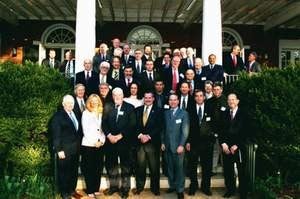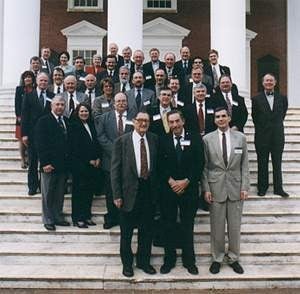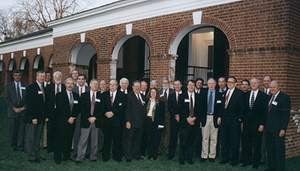Homeland Security and Terrorism Conferences
Hostage to Terrorism: Governmental and Non-Governmental Response Strategies
University of Virginia
Charlottesville, VA
April 3 to April 5, 2005

In May 2004, Nick Berg, an American businessman was taken hostage and executed by Islamic extremists operating in Iraq. Berg’s ordeal was the first of many such hostage events to play out in Iraq in 2004. The events were often broadcast internationally via the internet and other media outlets. Officials in Iraq, including American FBI agents from the Crisis Negotiation Unit, wrestled with the best strategies to deal with the events. The Critical Incident Analysis Group studied these events and strategies at its yearly conference held in Charlottesville, Virginia.
Countering Suicide Terrorism: Risks, Responsibilities and Realities
University of Virginia
Charlottesville, VA
April 4 to April 6, 2004

Conference participants posing for a group photograph.
The 2004 CIAG conference focused on the potential for suicide terrorism to reach the United States, and the potential for a terrorist focus on so-called ‘soft-targets’. To paraphrase Eric Stern, Director of Crismart at the Swedish National Defense College, we attempted to “focus on the history of our neighbors, in an effort to better understand how we can prepare for the future.”
Terrorism, Intelligence and Democracy
University of Virginia
Charlottesville, VA
April 7 to April 9, 2002
This conference focused on the issue of public preparedness, and the information that is needed to insure public preparedness and the practice of democracy. The community shielding concept was developed as a result of this conference, and is referenced elsewhere on this website.
Truly a collaborative effort, the products of this conference include the following:
- Virginia General Assembly Commendation
- Small Pox and Community Shielding With Good Reason Radio Program
December 2002
Audio File - Panic Button
Chronicle of Higher Education
March 14, 2003
Threats to Symbols of American Democracy
University of Virginia
Charlottesville, VA
April 10 to April 11, 2000

This conference examined the relationship between our architecture and symbolic understanding of government. It specifically investigated whether attacks on public buildings like the National Capitol and the Murrah Building are related in any way to the architecture and its symbolic value.
Terrorist Threat to the American Presence Abroad
University of Virginia
Charlottesville, VA
April 12 to April 13, 1999

This conference examined the Al Qaeda bombings of the U.S. Embassies in Kenya and Tanzania that had occurred the previous year. In the 1998 U.S. Embassy Bombings (August 7, 1998), hundreds of people were killed in simultaneous car bomb explosions at the United States embassies in the East African capital cities of Dar es Salaam, Tanzania and Nairobi, Kenya. The attacks, linked to local members of the al Qaeda terrorist network headed by Osama bin Laden, brought bin Laden and al Qaeda to significant international attention for the first time, resulting in the U.S. Federal Bureau of Investigation placement of bin Laden on its Ten Most Wanted list.
Along with the 1993 World Trade Center bombing, the 1996 Khobar Towers bombing in Saudi Arabia, and the Yemen-based 2000 attack on the Cole, the Embassy Bombing is one of the major anti-American terrorist attacks preceding the September 11, 2001, terrorist attacks.
The bombings were examined from the standpoint of academe, the private sector and the federal government.
